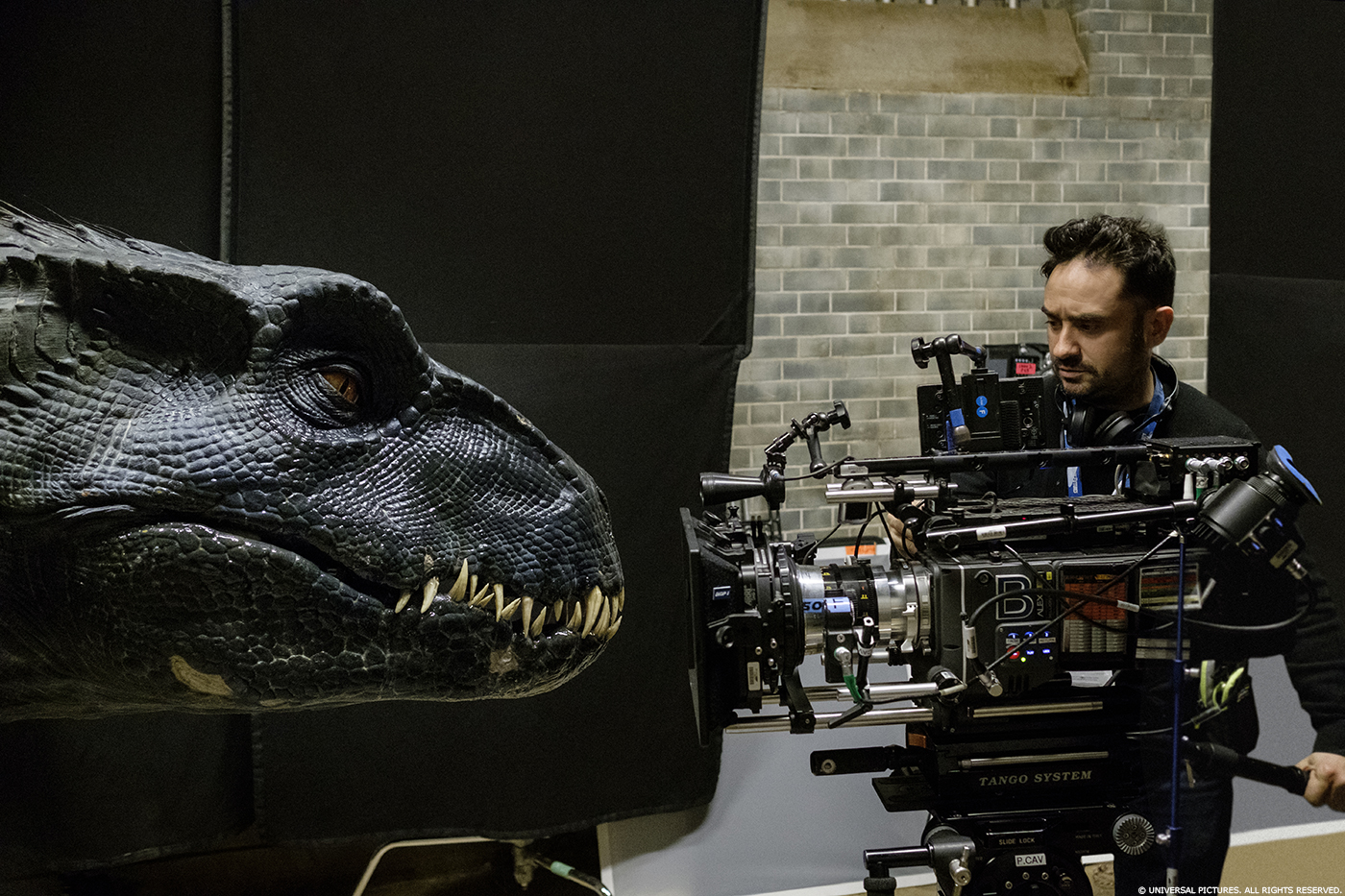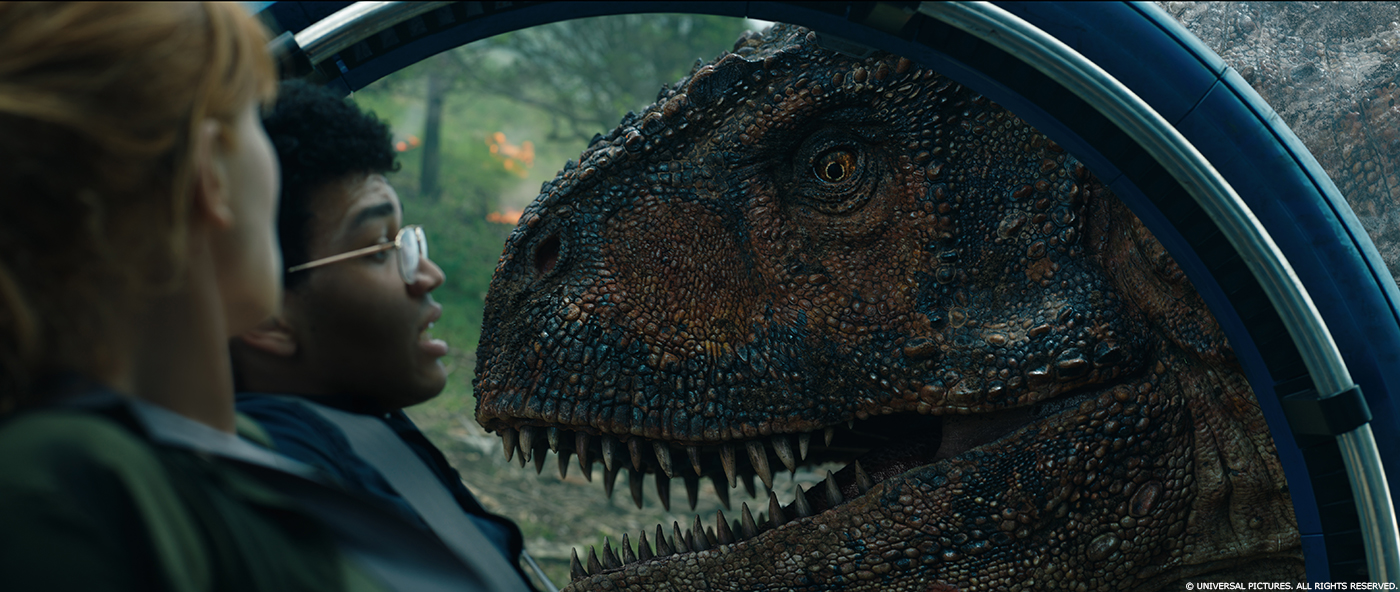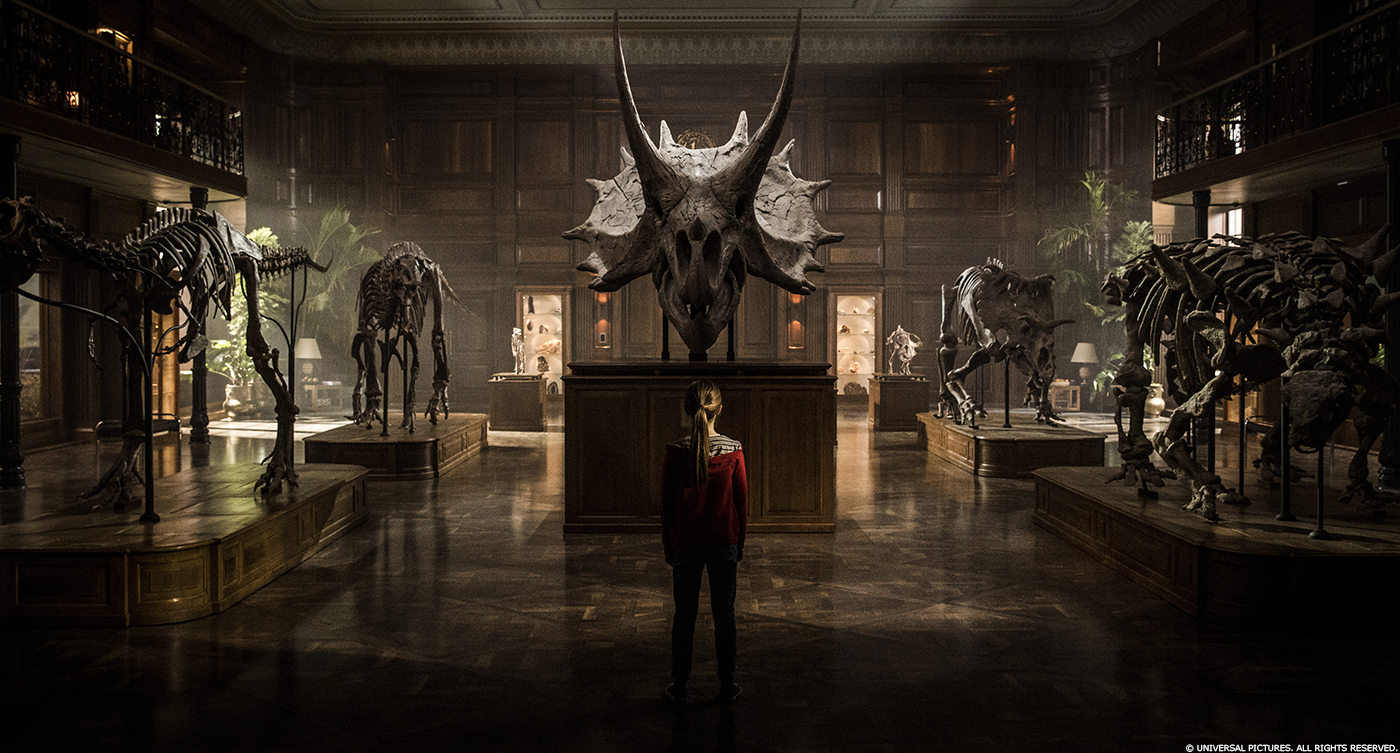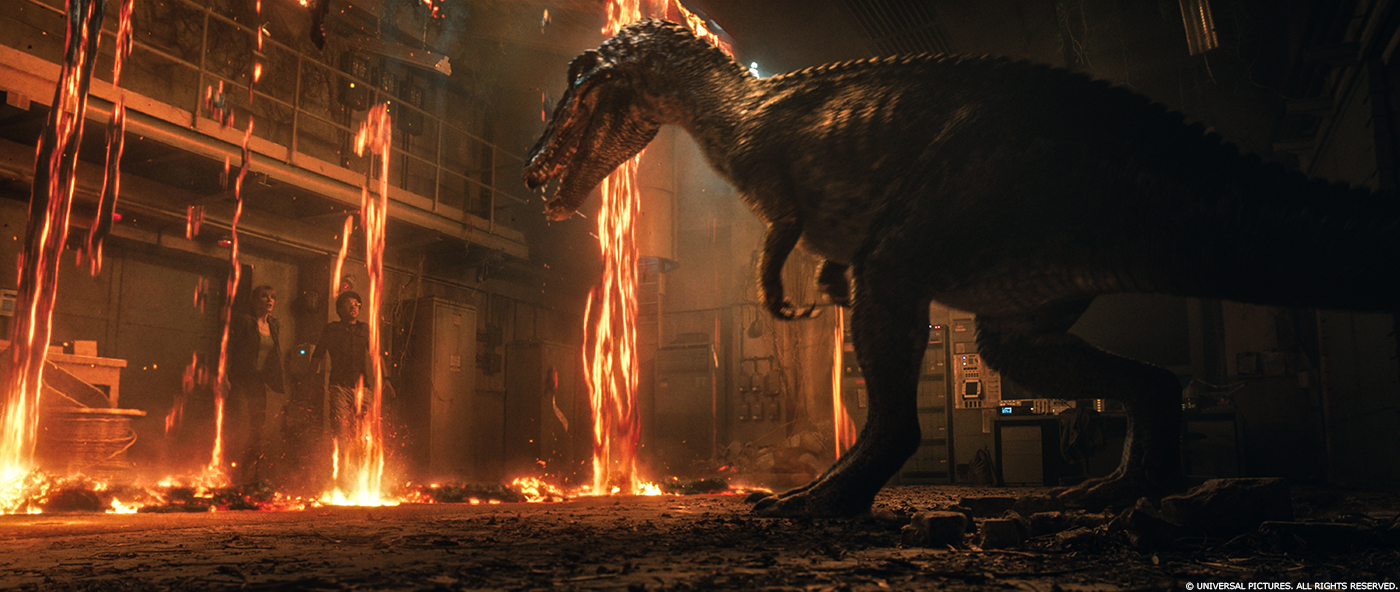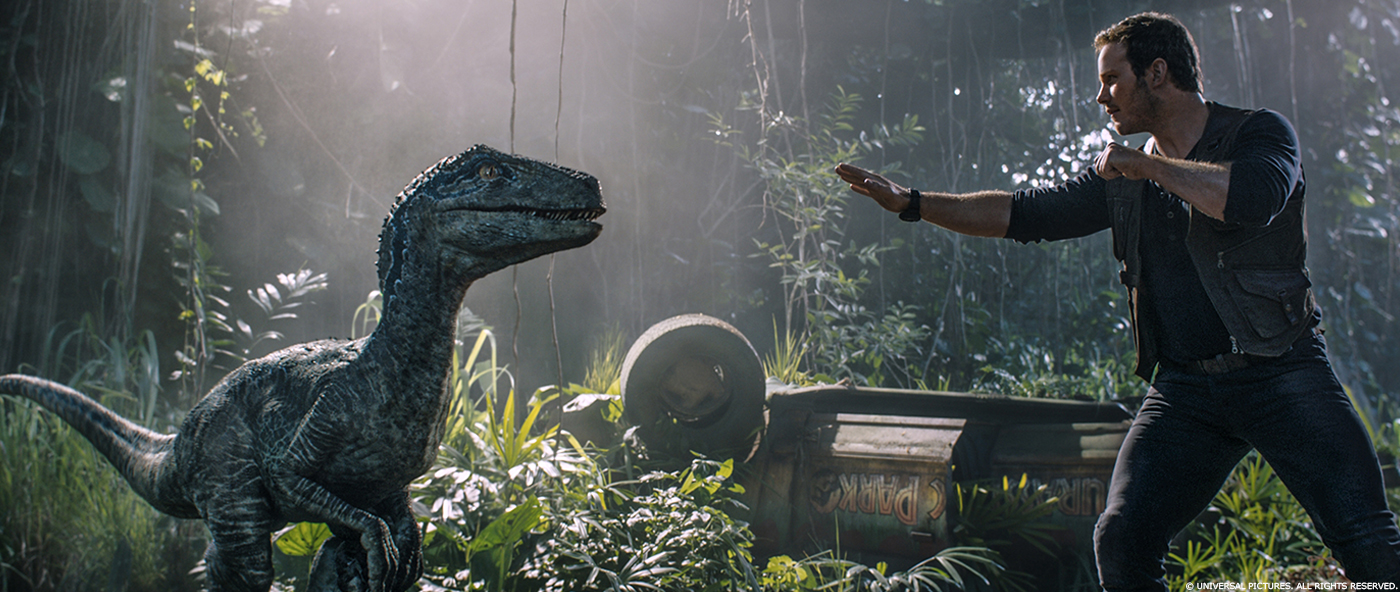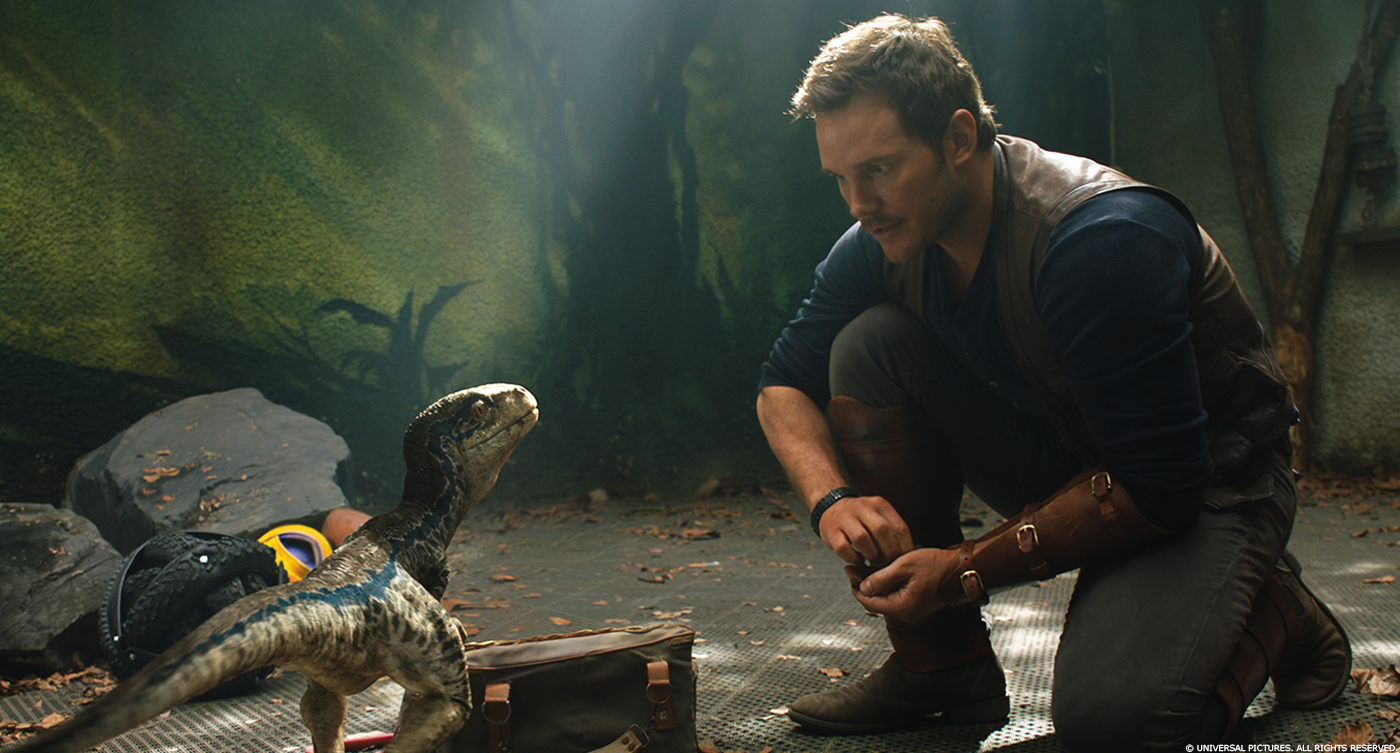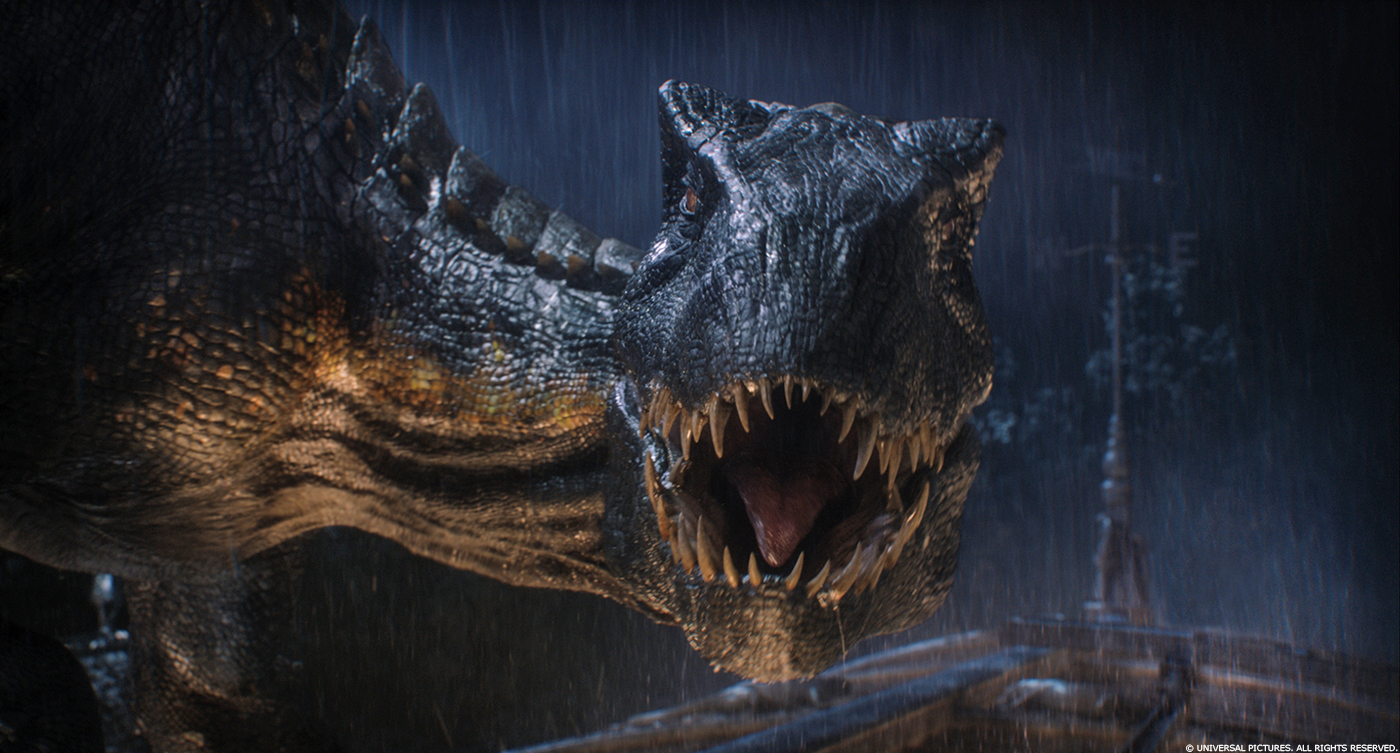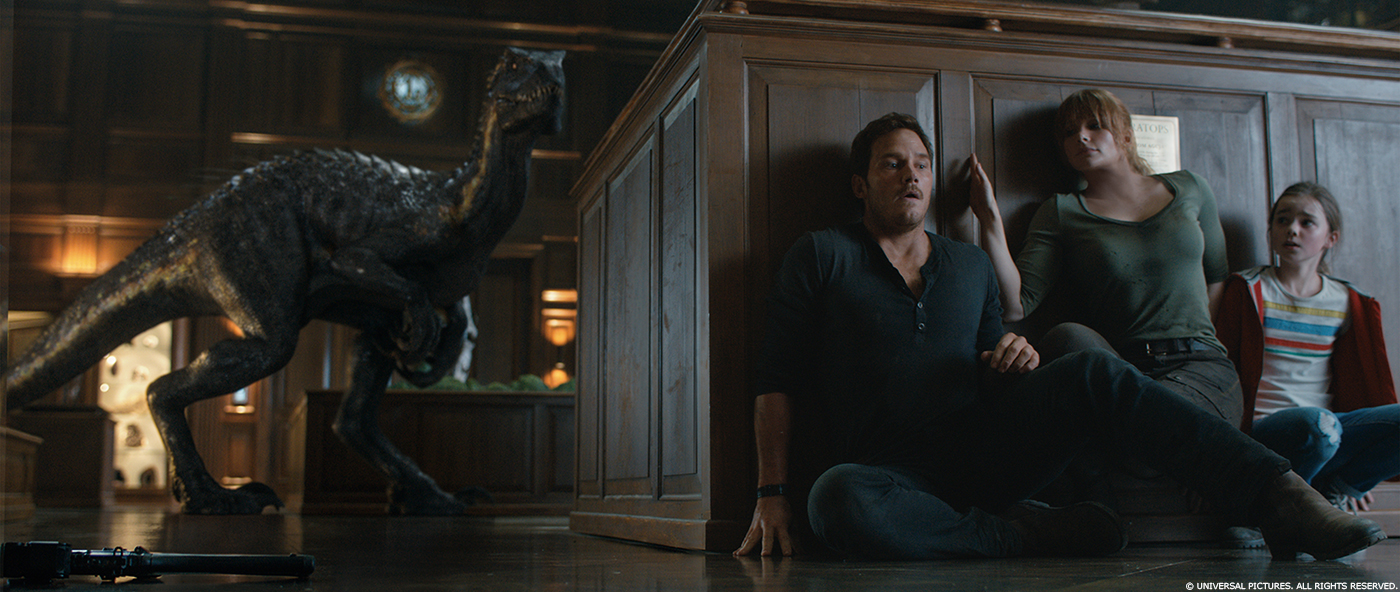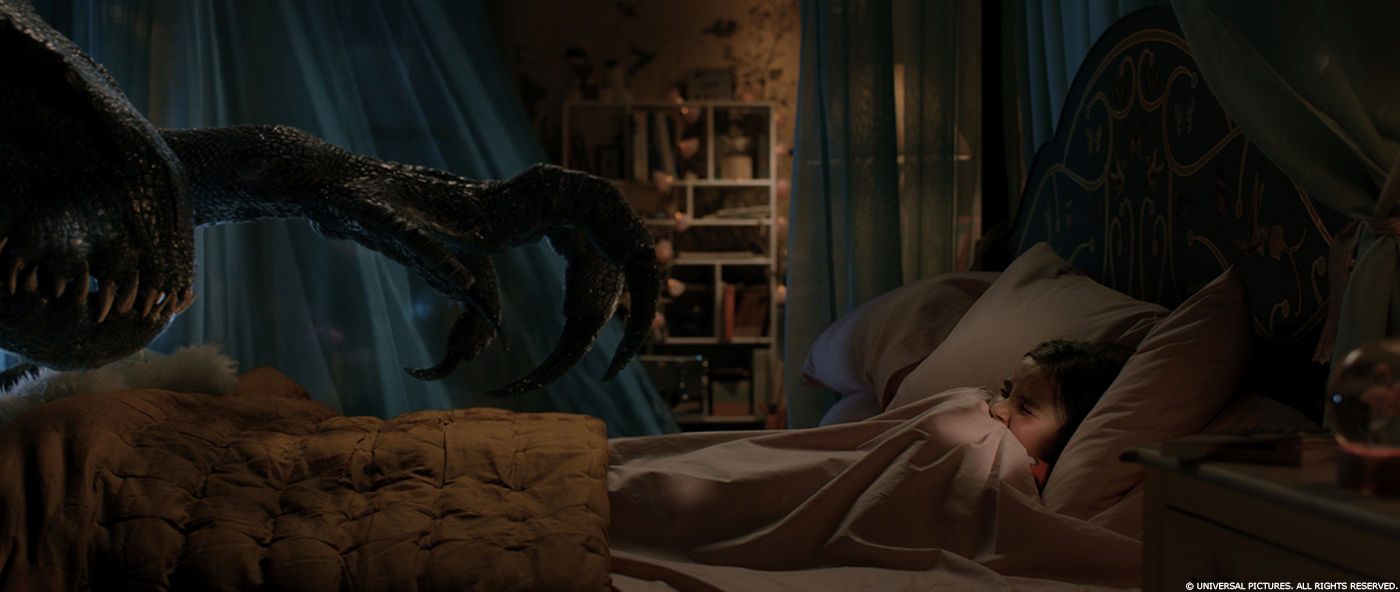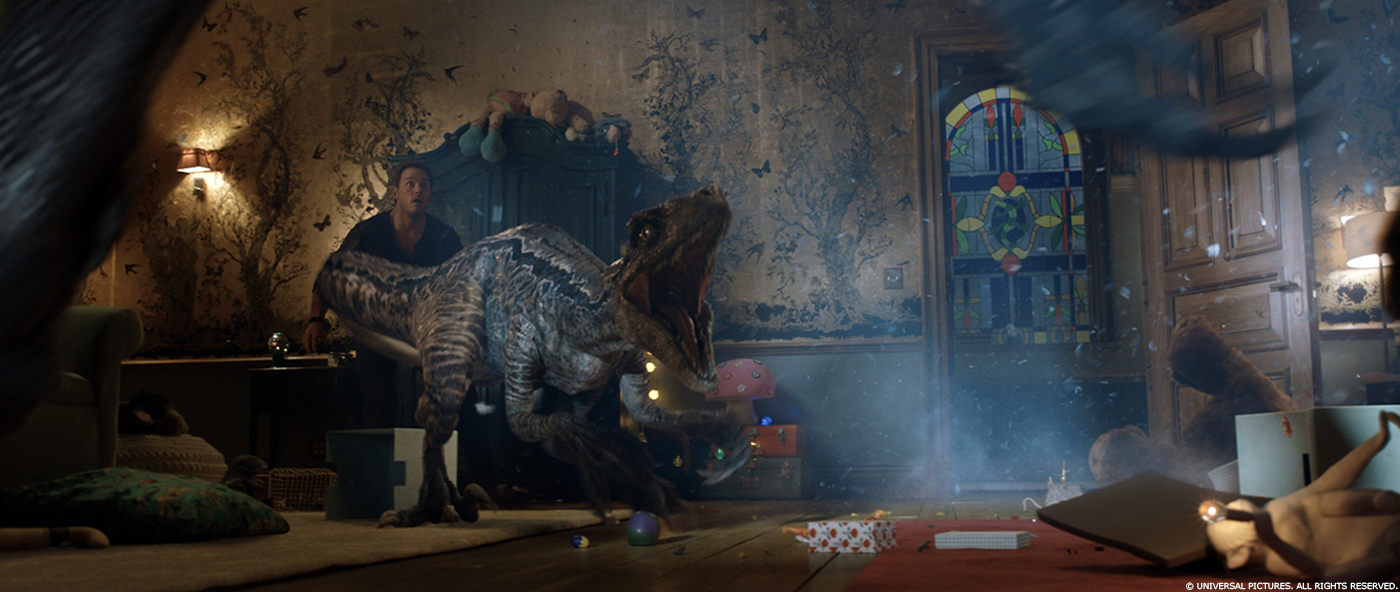In 2013, David Vickery explained the work of DNEG on FAST & FURIOUS 6. He then worked on JUPITER ASCENDING and MISSION IMPOSSIBLE: ROGUE NATION. He joined Industrial Light & Magic in 2016.
Last year, Alex Wuttke told us about the DNEG’s work on WONDER WOMAN and then joined ILM the same year.
Jance Rubinchik began his career in 2003 and worked at Electronic Arts, Tippett Studio and Weta Digital before joining ILM in 2017. He has worked on many films such as CLOVERFIELD, AVATAR, MAN OF STEEL, DAWN OF THE PLANET OF THE APES and KONG: SKULL ISLAND.
How did you get involved on this show?
David Vickery [DV] After I finished MISSION IMPOSSIBLE: ROGUE NATION I left Double Negative to join Industrial Light & Magic (ILM) and not long after I’d started there I got a call from Tom Hayslip, a producer I’d previously worked with on MISSION. Tom knew I’d moved over to ILM and was looking for a VFX supervisor for FALLEN KINGDOM. With J.A. Bayona at the helm this time around it made sense for to prep, shoot and post in the UK so ILM’s London studio was the natural choice to lead the project. I had joined ILM as a Creative Director for the London studio, filling in for Ben Morris whilst he was finishing STAR WARS: THE LAST JEDI. FALLEN KINGDOM was too big an opportunity to pass up, so in July 2016 I left the ILM office in Soho and went out to Pinewood to begin prep on the movie.
Jance Rubinchik [JR] I was working at ILM’s Singapore studio finishing up supervising anim on TRANSFORMERS: THE LAST KNIGHT. I was looking to be closer to home as my family is back in the USA. I threw my hand up for any possibility to be transferred to one of the other ILM studios. It was absolutely the right time as ILM needed an animation supervisor for the work being done here in London on FALLEN KINGDOM. Already being a huge fan of the franchise and an admirer of J.A. Bayona’s work, I was thrilled and jumped at the opportunity!
What was your feeling to be in the Jurassic Park universe?
[DV] It was hugely exciting, terrifying and inspiring in equal measures. I was a big fan of Bayona’s previous 3 films (THE ORPHANAGE, THE IMPOSSIBLE and A MONSTER CALLS) so was excited to find out what it was like to work with him. It was a great honour to be asked to collaborate on such an amazing franchise; one that was at least partially responsible for me getting into movies (I’m sure most people in our industry feel at least a little bit this way!) but also terrifying realising that I would have to follow in the footsteps of true legends of our industry – Dennis Muren and Phil Tippet, to name just a few.
Alex Wuttke [AW] Immense excitement on many levels. As a fan of the franchise, it’s an incredible experience being asked to make a contribution.
[JR] I was 12 years old when JURASSIC PARK hit theatres. I could not understand what I was seeing. How were dinosaurs alive on screen in front of me?!? JURASSIC PARK kickstarted my desire to work in visual effects. Now, 25 years later, I’m on the other side of that movie screen helping to create that magic. It’s not a feeling that is easily put into words.
How was the collaboration with director J.A. Bayona?
[DV] J.A. was a dream to work with. He’s incredibly decisive, but not afraid to let other people contribute ideas to his film. I really enjoyed my part as a creative decision maker on the project. Visual Effects were often asked to solve tricky story related problems and J.A. is very good at looking beyond a rough, WIP presentation of material to see the seeds of the ideas behind them. During prep I would often take the previs team down to the partially constructed sets at Pinewood and film sequences on our iPhones. We’d then cut sequences together with our visual effect editor. This seems like a pretty low-fi way to make a huge multi million dollar film and not all directors would react well to it. J.A. was happy to have people trying to work out ideas for him and responded really well to that approach.
[JR] Working with J.A. was exactly who you hope to work with for this type of project. He brought such a fresh new vision to this franchise, with the gothic horror elements he added, something we haven’t seen in a Jurassic film before. He was always very excited about the in-progress animation we would present to him. There was always clear direction for the action or mood he was after. J.A. Had a lot of faith in our team and there was a lot of creative freedom to explore ideas and try new things.
What was his expectations and approaches about the visual effects?
[DV] There’s a huge amount of human interaction with Dinosaurs in FALLEN KINGDOM and one of JA’s major concerns was how we ensure that this interaction translated into something that was completely convincing on camera. JA and I went through a really early draft of the script together and identified all those moments. I then came up with a proposal for all of the dinosaur bucks that we would use. In the end we had a lot of different performance pieces and stand-ins for our dinosaurs. Sometimes we’d use camera ready animatronics, other times we would rely on simple puppets that we knew we’d replace entirely in post, but we also had inflatable dinosaurs, a raptor helmet and tail that one of Neal Scanlan’s creature performers could wear on set, full scale styrofoam sculpts of tranquilised dinosaurs, concrete dinosaur heads that could smash solid brick walls and even simple cardboard cutouts we could use for eyelines. It was all about making sure we had a suite of practical tools we could use to get the right types of interactions on set.
[JR] J.A. wanted these Dino’s to feel more real than ever before. That meant getting close to these Dino’s, really close! We had make sure to have the level of detail and control in the face shapes to be able to sell the extreme closeups we see in FALLEN KINGDOM.
How did you split the work amongst the ILM offices?
[JR] The animation was split between the London and Vancouver ILM facilities. When you are splitting complex work like this, it makes it easiest for everyone involved if you can split a chunk out so you can handle a run of shots. I was constantly reviewing the work to make sure that shared characters such as Blue were consistent across the shared sequences.
[DV] ILM’s Vancouver studio handled the sequence where Owen first discovers Blue on Isla Nublar and the bulk of the Gyrosphere sequence (with the exception of the long underwater shot). Meanwhile our studio in London was the lead for the project so they handled all the sequences that take place off Isla Nublar and the main bulk of the asset build and lookdev. Our studio in San Francisco worked on the sequence towards the end of the movie where the dinosaurs are let out of their cages by Claire. We also brought in a number of third parties – Important Looking Pirates worked on the prologue and another sequence with Blue in the lab at Lockwood manor. One Of Us worked on a few sequences on Isla Nublar, but we also had El Ranchito, Scanline, Image Engine and The Post Office. Proof handled all the previs and postvis for the show.
Can you tell us more about the previz and postviz work?
[DV] Proof were responsible for all of the previs and much of the postvis work for the film. They were led by the very talented Previs Supervisor, Pawl Fulker. J.A. and I wanted to previs all the sequences that featured Dinosaurs to make sure we were framing correctly for those huge animals. It was important to identify where we needed to incorporate areas of damage and interaction between our Dinos and the sets in our principal photography and not always rely on post production for those interactive touches. There was a huge amount of work; almost 700 shots featured Dinosaurs in some way or another and we had a team of up to 15 artists working on the show for the entire of pre-production.
How did you use the ILM experience on the previous Jurassic Park movies for this new one?
[JR] ILM has such a great history with these movies, having created the visual effects for all of the film in Jurassic franchise. There is a wealth of animation reference to draw from so we started the show by restoring animation walk and run cycles, as well as behavioural tests done for the first JURASSIC WORLD film, for all the dinos we knew would be returning. This gave us our animation foundation to build upon.
[DV] It was great to be able to consult with JURASSIC WORLD Visual Effects Supervisor, Tim Alexander; I called him a lot, simply to pick his brains as to how he went about shooting JURASSIC WORLD. Quite a few of the shooting crew on FALLEN KINGDOM also worked on JURASSIC WORLD and by repeating some of the VFX on set methodologies the crew were immediately more accepting of our dept. Dennis Muren would often sit in on our internal VFX reviews and, as you would expect he is always looking to raise the bar; technically and aesthetically. It was a dream to have him critique our work. We were also very lucky to have Glen McIntosh on the show. Glen was the animation supervisor on JURASSIC WORLD. He basically is Blue… He knows how she moves and reacts to different scenarios. On set he would work with the creature team, coaching them in how to move and behave like a dinosaur!
How did you work with the animatronics team?
[DV] Neal Scanlan and I spent a lot of time in pre-production working very closely together to make sure we got the best out of both the visual effects and the practical creature effects. It was important to me that we play to the strengths of each of our respective disciplines and not just opt for the easy option. For example, the incredible animatronic set pieces of Blue and the Trex were initially driven by visual effects. We took the 3D models from ILM and posed them in the most appropriate positions based on previs. Starting with the animatronics in the most optimal pose would minimise creasing, folds and tears appearing in the latex skin of the sculpts due to pushing them beyond their range of motion. We baked incredible detail from ILM’s highest resolution texture maps into the posed digital models so that with the dinosaur at 1:1 scale, each polygon was no larger than 1 square mm. This resulted in some truly huge 3D files with hundreds of millions of polys. Neal Scanlan took those files and 3D printed them at full scale and this formed the basis for his animatronic models. It meant that we could guarantee the authenticity of the animatronics. When it came to post we were able to line up our 3D posed dinosaurs with the animatronic and almost perfectly register every single scale on the digital dinosaur with its animatronic counterpart. It made the job of seamlessly blending the digital and practical models possible and was a huge contributing factor to the success of the collaboration between Neal’s team and our team at Industrial Light & Magic.
Where were the different sequences of the movie filmed?
[DV] For the most part we filmed at Pinewood Studios, but we also had some location work at Langley, Bourne Wood and a national trust property in Northumberland called Cragside, which doubled as a location for Lockwoods manor. Then we were lucky enough to be able to shoot in Hawaii for 6 weeks, which was an amazing experience.
How did you work with the SFX and stunts teams?
[DV] There was such a great spirit of collaboration between all the departments on the film, but with visual effects playing such an important role on the project we naturally became the go-to department for answers to all the tricky questions. We tried to be as proactive as possible when it came to sharing our 3D assets. The stunt team would do their own ‘Stunt-vis’ for fight sequences and we shared dinosaur animation cycles so that they could postvis dinosaurs into their edits.
Paul Corbauld’s Special Effects team worked very closely with the VFX dept. We had a number of complex mechanical SFX rigs that needed to be built for the shoot, we sent them our Gyrosphere models from JURASSIC WORLD and using our tech-vis as a guide we were able to help them spec out the 4 different rigs that we needed Gyrosphere sequences. Our previs for the Gyrosphere sequence in Hawaii was based on geographically accurate photogrammetry of the Kualoa ranch valley (where the sequence was filmed) So we were able to translate that previs into a map detailing where all the pyro explosions, smoke machines and fire bars needed to be placed in the real world.
The Volcano escape sequence involve many dinosaurs. How did you manage their animations?
[JR] The volcano escape sequence was predominantly handled by our Vancouver team. With the animation being overseen by Glen McIntosh. We decided not to use any crowd systems for this sequence. Due mainly to the complexity of the sequence and the demanding performances these dinos needed to deliver. The shots began with blocking in run cycles for the dinos to get the number and type of dinos locked down. From there the animators would work in the complex interaction, stumbling, tripping, reactions to exploding lava bombs etc. We then needed to refine the animation to add variation so every triceratops and stygimoloch didn’t run the same as one another. It was a lot of work, animated by hand, to create the believable stampede you see on screen!
There are various fights between the dinosaurs. How did you create and animate these choregraphies?
[JR] For the Blue and Indoraptor fight in Maisie’s bedroom we had very little in the way of previs to start with. We had the plates and a rough idea of what needed to happen from J.A. I wanted to block out the full fight before presenting back to J.A. I decided to start with a motion capture session at the ILM stage here in London and that allowed us to very quickly try out a lot of ideas. Dinosaur anatomy is very different from a humans’ so the mocap will only get you so far. We then took the mocap and started rough blocking in the action across the sequence. Once we had something that JA was happy with, I started to refine the fight choreography. We heavily referenced large dogs fighting to get the sense of frenzied action we needed. For complex, specific action like this, where you can’t just go and film a real dinosaur, I needed to rely on experience and any real world reference I could find.
[DV] Midway through the Gyrosphere Escape sequence there’s this amazing fight between a carnotaurus and a sinoceratops. We’d prevised that action extensively in pre-production with Pawl Fulkers team, but when it came to the shoot the decision was made to cut that beat altogether because it was felt to break the tempo of sequence to much. Almost 8 months later, when we were deep into post-production J.A. and Producer Colin Trevorrow asked me if we could add the sequence back in, but of course, we hadn’t shot any coverage or plates for it, because it had been cut. Bernat Vilaplana (Editor) and I had to think really fast and were able to rough together a 2D animatic based on the plates we did have. The really tricky part was maintaining a connection with our actors during that moment, when nothing had been shot for it. We turned the sequence over to ILM and Glen McIntosh and his team really came up with some amazing choreography. Glen would show me reference of Bulls fighting – he wanted to sell the energy of the impact when these two huge dinosaurs locked horns. We ended up rebuilding a lot of background plates to make the action work, lowering the cameras to give the dinosaurs the towering presence over the viewer that showed them in their best light. We even had to replace Chris Pratt in one shot with a digi double just to be able to lower the camera 2 feet closer to the floor and maintain the correct perspective on his element.
Blue is back. How did you update his model and his shaders?
[AW] For all the returning dinosaurs, we went through a process of increasing detail, both in terms of textures but also in sculpt detail. This was also the case for Blue. Specifically for Blue, we enhanced some of her key aspects, such as adding a little extra iridescence into her signature stripe.
Can you tell us more about the super cute baby raptors?
[DV] The baby raptor sequence was actually the first sequence we shot during principal photography, and I really wanted to make sure we had something physical for Chris Pratt to interact with on set. I asked Neal Scanlan to build us some 1:1 scale, articulate rod puppets, so during photography we had a performer 2-feet behind the baby raptor puppeteering baby blue for every shot. It gave us a wonderful interactive dialogue between Chris and the dino that you would never have gotten with the old tennis ball on a stick. Chris never knew if Blue would shy away from him or leap up at any moment. I think that’s a big part of why we got such a successful performance. We often had as many as four baby raptor puppets (and the humans controlling them) on screen at a time. This would have made for a huge amount of cleanup, so we bought some small radio controlled vehicles that could actually jump 2-feet in the air using small spring-powered rams. It was hilarious watching Chris walking through the set with 4 radio controlled vehicles racing around him, jumping up and down, but this gave the cameraman and Chris something to work with rather than imagining what was going on around them.
[JR] The baby raptors were so fun to animate! We are so used to seeing these dinos big, scary and eating people. Now we get to see them running around and playing. I think that is what makes it such a special moment in the film. We used a variety of reference to bring them to life, predominantly baby puppies to get the cute and excited temperament. We also found reference of baby emu running around and playing. That reference was ideal as the anatomy is so similar to the baby raptors, especially the leg structure.
Let’s talk about the new dino, the Indoraptor. Can you explain in detail about his design and creation?
[DV] Including the Indoraptor we designed seven new dinosaurs for FALLEN KINGDOM and they all presented very unique challenges. When designing those animals we would always start with the best scientific information we could dig up. We visited museums and studied fossil records to make sure that we were creating authentic animals. The difficulty with the Indoraptor though was that it’s not a real dinosaur, it’s a genetic hybrid, a cross between the Indominus Rex and a velociraptor – so whilst we could lean on the anatomy of those dinosaurs for a starting point, we had to be very careful not to create something felt too much like a monster.
The first thing we looked into was how big would the Indoraptor be. We knew that we had sequences which played out in very confined spaces back at Lockwood manor, so the size of our dino had a very big impact on all the sets that Andy Nicholson (Production designer) would build. Andy shared all his digital set models from art dept with us and we put together a series of animation studies to see how the Indoraptors size would affect the way it could move around the house. It needed to fit in small bedrooms and narrow hallways, climb staircases and scale rooftops as well being able to hide in plain sight in the larger diorama room. These scale tests helped us settle on the Indo’s eventual size (10ft to the top of his head when he is standing) but they also allowed Andy to adjust his set builds to work with the Indoraptor. Andy deliberately made rooms bigger and corridors smaller so that the sequences that took place in each set played to the size of the dinosaur perfectly.
All the new dinosaurs were initially concepted by ILM Art Department concept designer Jama Djubarev. Jama would spend 2-3 weeks on each dinosaur sculpting a base mesh in Zbrush. We’d use this sculpt to sign off overall proportions and anatomy and then Jama would paint two key images to start looking into colour, texture and the finer details of claws, spines and skin wrinkling. At the same time we’d collate reference images which formed a mood board for the new dino. For me the mood board was a crucial part of the process. They gave everyone a dinosaur bible to refer back to throughout production. On it we reference lots of real animals and how various traits of those animals should be reflected in the design of the dinosaur in question. For example, for the Indoraptor we looked at the scale flow patterning and reflective qualities of Black Tree monitor lizards. The Indo’s claws are referenced from Iguana’s, the yellow markings along his side take inspiration from Red bellied black snakes. We even looked at venomous sea urchins and took elements of them for the quills that sprout from the back of his head. I felt that the more we were able to see elements of real animals in all our new dinosaurs the more believable and relatable those creatures would become for our audience. At the same time as this we rigged our zbrush sculpt for animation so that Jance could start playing… Those early animation studies really paid off, because we very quickly realised that, whilst the Indo looked great as a still image, his body proportions needed to be adjusted to allow him to move around. Early animation tests looked ungainly because the Indo’s fore-arms were too long and his torso was too short. When he walked as a quadruped his elbows collided with his knees and he didn’t look in the least bit scary. We adjusted the model to get a more logical shoulder to hip length and slightly shortened the arms and it made a huge difference to the way the animators could make him move around.
What kind of reference and indications did you receive from him?
[DV] Aside from the real animals we referenced (see above) we got some very obscure references from J.A., but it really helped us build and flesh out the Indo’s character. Glen McIntosh had shown JA a picture of a shell-shocked World War 1 soldier in the trenches. It was this grainy black and white image, the soldier had incredibly haunting eyes and a detached expression on his face. When J.A. saw it he said – ‘that’s what I want the Indoraptor’s eyes to look like’ – not a reference that I was expecting for a dinosaur at all! But it really helped me understand how J.A. felt about the Indo. J.A. also referenced Nosferatu a lot – you can see that reference clearly in the design of his hands and claws.
Can you tell us more about his animation?
[JR] Indoraptor is a dinosaur that was built to be a weapon. He has never been shown kindness or compassion. As a result he lacks remorse and empathy. He was raised in a cage and trained to kill by scientists and mercenaries that do not care for him. This is important, so we can understand what’s going on in his head. Indo hates humans, he takes pleasure in killing them. This is what guides our decisions on how Indo would deal with any given situation. I wanted to convey all that hate and rage, the psychotic nature of an animal born into this life. Indo is a direct product of over genetic engineering, he is a genetic cocktail over mixed! This DNA tampering has presented itself through uncontrolled muscles spasms as well as head and finger twitches. We developed customized controls across Indo’s shoulders, back, chest and thighs that allowed the animators to trigger these muscle contractions whenever Indo would be tense or angry. This drove the muscle sims and it added a lot of realism and a sense of underlying structure.
What was the main challenge with the Indoraptor?
[JR] The Indoraptor is a brand new dinosaur, making him stand apart from what we have seen in the previous Jurassic films but still feel a part of this universe was a big challenge. Unique to Indo is the fact he can switch between biped and quadruped locomotion. We had to make sure his anatomy would support that action. His arms couldn’t be too long or too short. His shoulders needed to be low and a bit further back. His neck and head needed to realign, depending on whether he was on two legs or four, so his posture wouldn’t feel craned or awkward. Working out the physics during both modes and the transitions between them was definitely tricky.
What is your favorite dinosaur?
[AW] There are so many to choose from! For me, the Indo was the standout character in terms of dramatic opportunity. J.A.’s desire to manifest his psychopathic nature in his performance gave us a huge opportunity to come up with some interesting performances. He also looks super cool!
[JR] Don’t make me choose – The velociraptor or T-Rex from the original JURASSIC PARK were so scary and awesome, it totally warped my brain! Indoraptor I’m sure will have an even more profound effect on kids seeing this dino for the first time. A dinosaur creeping into your bedroom at night, I may never sleep again!
Can you tell us more about your collaboration with their VFX supervisors?
[AW] All the supervisors across our roster of vendors were fantastic. Our approach was to give them creative freedom so that they could own the work, but at the same time give them examples of how shared assets should look or move so that we all had a common grounding for visual and performance continuity. It was hugely beneficial to have a broad range of talent spread across the show in supervision terms, so that the creative vision was always condensed into each area as opposed to being too diffused across the whole show.
The vendors are all around the world. How did you proceed to follow their work?
[AW] We organised cineSync and video conference sessions on a weekly and often bi-weekly basis to stay on top of the work and to communicate changes rapidly.
Which sequence or shot was the most complicated to create and why?
[AW] The shot of Claire and Franklin within the gyrosphere sinking into the ocean was the most complex in terms of logistics. This shot was actually comprised of multiple takes and performances shot across multiple days in the tank at Pinewood. We had to blend the multiple shots into a single seamless shot. The actors could only remain submerged within the buck for short periods of time so to pull off the effect of one long shot, we had to blend multiple takes and performances. We used every trick in the book, blending from live action into digi-doubles at points, switching to fully digital representations of the gyrosphere for others, all whilst executing a complex digital environment outside the gyrosphere, with lava bombs plunging through the water and drowning dinosaurs.
Is there something specific that gives you some really short nights?
[DV] The internet! It sounds silly, but we make films for our audiences and the Jurassic franchise has such a huge and dedicated fan base. So many people grew up with Jurassic and a lot of the people in our industry were inspired to get into visual effects and filmmaking because of the experience they had when they first watched JURASSIC PARK. There was a lot of pressure to get it right. I hope we are able to inspire a new generation of dinosaur-loving filmmakers.
[AW] At every step we wanted to be sure we were maintaining the quality levels established by those that had gone before us.
What is your favorite shot or sequence?
[DV] That’s a really hard question, I have so many favorite shots in the film. There is one particular shot at the private airfield as Clare, Owen, Zia and Franklin leave for the island. This tiny plane hurtles down the runway and takes off, silhouetted against the sunrise. Principal photography was shot at a small airfield in the U.K., but by the time we got to shoot the plane taking off we had lost the light. For most of the shots we replaced the rather mundane U.K. background to add in a northern American mountain range, but the very last shot as the plane takes off is completely CG. ‘One of Us’ did all the work on and it’s very deliberately designed to look like something you would see in Indiana Jones (which is another franchise very close to my heart). I used to play the ‘Raiders march’ when we presented it to J.A. and he loved it! The shot really captures the spirit of adventure that the sequence needs and I love that it’s such a seamlessly real, fully digital creation. The little details in the plane’s animation to make the wings wobble are a great touch.
[AW]: I love the shots of Indo hunting our heros through the Lockwood mansion. There’s so much tension in those shots and they really let the subtle work done by everyone sing through.
[JR]: The Indo stalking Owen and Maisie on the roof in the rain – Such a great sequence! My favorite shot though is Indo climbing down the roof in the rain before entering Maisie’s bedroom. If I hadn’t watched us make it I would swear it was really up there…. and I would never sleep again.
What is your best memory on this show?
[DV] Tricky question! It’s got to be a toss up between the excitement of the first day on set, and the relief of delivering the final VFX shot in post. Perhaps a close second was that day off in Hawaii where we all went surfing!
How long have you worked on this show?
[DV] I started on the show at the beginning of July 2016. So very nearly 2 years.
What’s the VFX shot count?
[DV] In total, we completed almost 1200 visual effects shots for FALLEN KINGDOM. That seems like a really low shot count for such a big visual effects movie, but the shots had very high frame counts. We really tried to get as much as we could in camera, building complex sets that were often tricky to shoot in and taking our actors to real locations whenever we could. Sometimes this actually made the VFX shots more complex to execute, but it gave us photography with a really solid foundation based in reality and left the VFX work to where it was really needed – the dinosaurs.
What was the size of your on-set team?
[DV] On set we had 2 VFX Supervisors, one for each unit (Alex Wuttke on 2nd Unit and myself on Main Unit) We also had a small army of Data Wranglers, Production Coordinators and Creature FX Performers. We even had a Stuffie Wrangler – Someone had to keep track of all the lighting reference sculpts and dinosaur performance pieces we had commissioned for use during photography. We often had as many as sixteen people split across the two units.
A big thanks for your time.
// WANT TO KNOW MORE?
Industrial Light & Magic: Dedicated page about JURASSIC WORLD: FALLEN KINGDOM on ILM website.
© Vincent Frei – The Art of VFX – 2018


